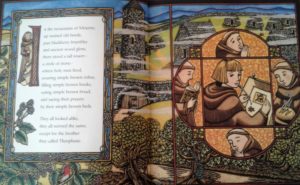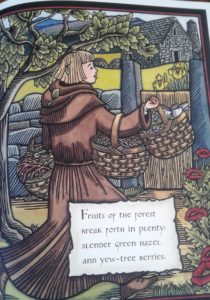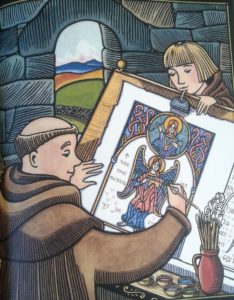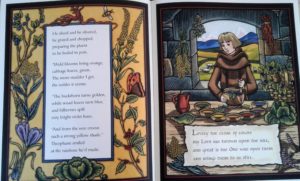
C.M. Millen
Illustrated by Andrea Wisnewski
When I was teaching at a classical Christian school, in a multi-level classroom, we studied the history of the Middle Ages and Renaissance every three years. I always looked forward to the projects related to the preservation of ancient manuscripts and the art of illumination. Some of the now-adult students from my very first class will always remember copying the first verse of the book of I John while windows and doors stood open in mid-winter Wyoming. We wanted to get a feel for what the monks endured. It was my students’ first experience writing with a feather pen, the nib of which they had cut themselves, and dipping it in a bottle of ink. We really did a pretty good job of cleaning India ink out of the carpet after our only major spill. The crowning moment in the project was getting to add gold leaf to the illuminated initial letter.
My favorite children’s resource for these projects was Marguerite Makes a Book by Bruce Robertson.
The Sailor Who Captured the Sea: A Story of the Book of Kells by Deborah Nourse Lattimore is also a beautifully illustrated history-through-literature resource.
I’m adding a new book to my magic carpet bag of lovely resources. The Ink Garden of Brother Theophane by C.M. Millen. Millen imagines a time when Irish monks, diligently copying their manuscripts, had only brown ink to work with.

Theophane does his work willingly, but has a difficult time concentrating. He carries crumbs left over from meals to the scriptorium so he can feed the birds who alight on the windowsill. He stops working to gaze at the beauty outside the window. This becomes so distracting to the other monks that the teacher of the scribes decides Theophane needs a new job. He is assigned to work in the pit of the tower stirring the cauldrons of boiling bark that is used to make the ink. Again, he works willingly, but it is a hot and exhausting job.
The next time he gets an opportunity to go outside, he runs, trips, and falls into a blackberry patch. The purple stains on his hands from the berries make him think of trying to concoct different colors of ink. What other colors might he be able to make from berries, leaves, and roots?

When he’s finished experimenting:
Heavenly hues
now covered their pages
and filled their bright books
with colorful phrases.

Now Theophane tends the plants he cultivates for the ink colors they make. He has the peace of mind that comes from knowing he has found his vocation.

The “Author’s Note” at the end of the book gives a little more history of the work of the Irish monks during the Middle Ages. She also lists further resources. The poems found on the right hand pages are from a collection made of actual doodles the monks made on scraps of parchment or in the margins of books when they were bored. Some of which can be found in The New Oxford Book of Irish Verse, edited by Thomas Kinsella.
She lists two other resources. I reviewed Across a Dark and Wild Sea here.
https://www.amazon.com/Across-Dark-Wild-Single-Titles/dp/0761315349/ref=sr_1_1?s=books&ie=UTF8&qid=1548971730&sr=1-1&keywords=across+a+dark+and+wild+sea
I have not yet read this one. https://www.amazon.com/Magic-Margins-Medieval-Tale-Bookmaking/dp/0618496424/ref=sr_1_1?s=books&ie=UTF8&qid=1548971878&sr=1-1&keywords=Magic+in+the+Margins
Millen also lists some websites where you can learn to make ink from plants and see how illuminated manuscripts were made.
I love stumbling upon resources that are as attractive as they are packed with information. And here’s another.
Brother Hugo and the Bear is another picture book that looks at medieval monastic scribes. But I love Brother Theophane! I do illuminated manuscripts in the fourth grade art class I teach for our co-op and now you’ve inspired me to look into having them make their own quills!